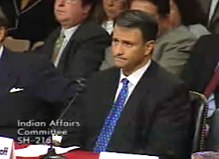 The lawmakers, lobbyists, Bush administration officials, congressional staffers and businessmen caught up in the Jack Abramoff public corruption probe: Abramoff was sentenced in September 2008 to four years in prison on charges of mail fraud, conspiracy and tax evasion. Since pleading guilty in 2006, the once-powerful lobbyist has cooperated with the federal investigation of influence-peddling in Washington.
The lawmakers, lobbyists, Bush administration officials, congressional staffers and businessmen caught up in the Jack Abramoff public corruption probe: Abramoff was sentenced in September 2008 to four years in prison on charges of mail fraud, conspiracy and tax evasion. Since pleading guilty in 2006, the once-powerful lobbyist has cooperated with the federal investigation of influence-peddling in Washington.
He was sentenced to a six-year prison sentence in a criminal case out of Florida, where he pleaded guilty in January 2006 to charges of conspiracy, honest services fraud and tax evasion in the purchase of gambling cruise boats. He was released to a halfway house in June 2010 and then home confinement and has been working at a pizzeria.





 Facebook, however, does what Chairman Mao, Joseph Stalin, or Adolf Hitler could not have dreamt of - it has a half billion people willingly doing a form of spy work on all their friends, family, neighbors, etc.—while enthusiastically revealing information on themselves. The huge database on these half a billion members (and non-members who are written about) is too much power for any private entity—but what if it is part of, or is accessed by, the military-industrial-national security-police state complex?
Facebook, however, does what Chairman Mao, Joseph Stalin, or Adolf Hitler could not have dreamt of - it has a half billion people willingly doing a form of spy work on all their friends, family, neighbors, etc.—while enthusiastically revealing information on themselves. The huge database on these half a billion members (and non-members who are written about) is too much power for any private entity—but what if it is part of, or is accessed by, the military-industrial-national security-police state complex? Witnesses said Kristien Garrett's one-year-old daughter and Garrett's mother Trina Woodcox were struck a number of times as the officers moved to detain Garrett's husband. Sean Garrett was allegedly handcuffed, beaten repeatedly and subjected to racial slurs while in custody; he was later released when ministry officials determined that his visa was valid.
Witnesses said Kristien Garrett's one-year-old daughter and Garrett's mother Trina Woodcox were struck a number of times as the officers moved to detain Garrett's husband. Sean Garrett was allegedly handcuffed, beaten repeatedly and subjected to racial slurs while in custody; he was later released when ministry officials determined that his visa was valid. The testimony in a lawsuit brought by the U.S. activist's family marks his first public comments since the woman's 2003 death in Gaza. Speaking from behind a screen, he says he remembers little.
The testimony in a lawsuit brought by the U.S. activist's family marks his first public comments since the woman's 2003 death in Gaza. Speaking from behind a screen, he says he remembers little. This is a question that I have wondered about as well. How do they keep all those people quiet, or acting against their own and society's best interests? The fact that the Federal Reserve system is still fully "operational", like the Star Wars Death Star, is proof enough that a large number of people can somehow be persuaded to "keep their mouths shut".
This is a question that I have wondered about as well. How do they keep all those people quiet, or acting against their own and society's best interests? The fact that the Federal Reserve system is still fully "operational", like the Star Wars Death Star, is proof enough that a large number of people can somehow be persuaded to "keep their mouths shut". The US military gave a secret order not to investigate torture by Iraqi authorities, Pentagon logs on the Iraq War leaked by the whistle-blowing website Wikileaks have disclosed. The disclosure was included in almost 400,000 US military files leaked by Wikileaks to The Guardian, New York Times, Der Spiegel and Al-Jazeera.
The US military gave a secret order not to investigate torture by Iraqi authorities, Pentagon logs on the Iraq War leaked by the whistle-blowing website Wikileaks have disclosed. The disclosure was included in almost 400,000 US military files leaked by Wikileaks to The Guardian, New York Times, Der Spiegel and Al-Jazeera. For nearly two decades, Lillian McEwen has been silent -- a part of history, yet absent from it. When Anita Hill accused Clarence Thomas of sexual harassment during his explosive 1991 Supreme Court confirmation hearing, Thomas vehemently denied the allegations and his handlers cited his steady relationship with another woman in an effort to deflect Hill's allegations.
For nearly two decades, Lillian McEwen has been silent -- a part of history, yet absent from it. When Anita Hill accused Clarence Thomas of sexual harassment during his explosive 1991 Supreme Court confirmation hearing, Thomas vehemently denied the allegations and his handlers cited his steady relationship with another woman in an effort to deflect Hill's allegations. The Nevada Supreme Court refused to overturn former football star O.J. Simpson's armed robbery and kidnapping convictions stemming from a Las Vegas hotel room heist at gunpoint.
The Nevada Supreme Court refused to overturn former football star O.J. Simpson's armed robbery and kidnapping convictions stemming from a Las Vegas hotel room heist at gunpoint. New observations this year about snow, ice and temperatures support the conclusion that the Arctic is unlikely to return to the conditions known in the 20th century — and that's likely to affect the weather in the lower 48 United States.
New observations this year about snow, ice and temperatures support the conclusion that the Arctic is unlikely to return to the conditions known in the 20th century — and that's likely to affect the weather in the lower 48 United States.






























